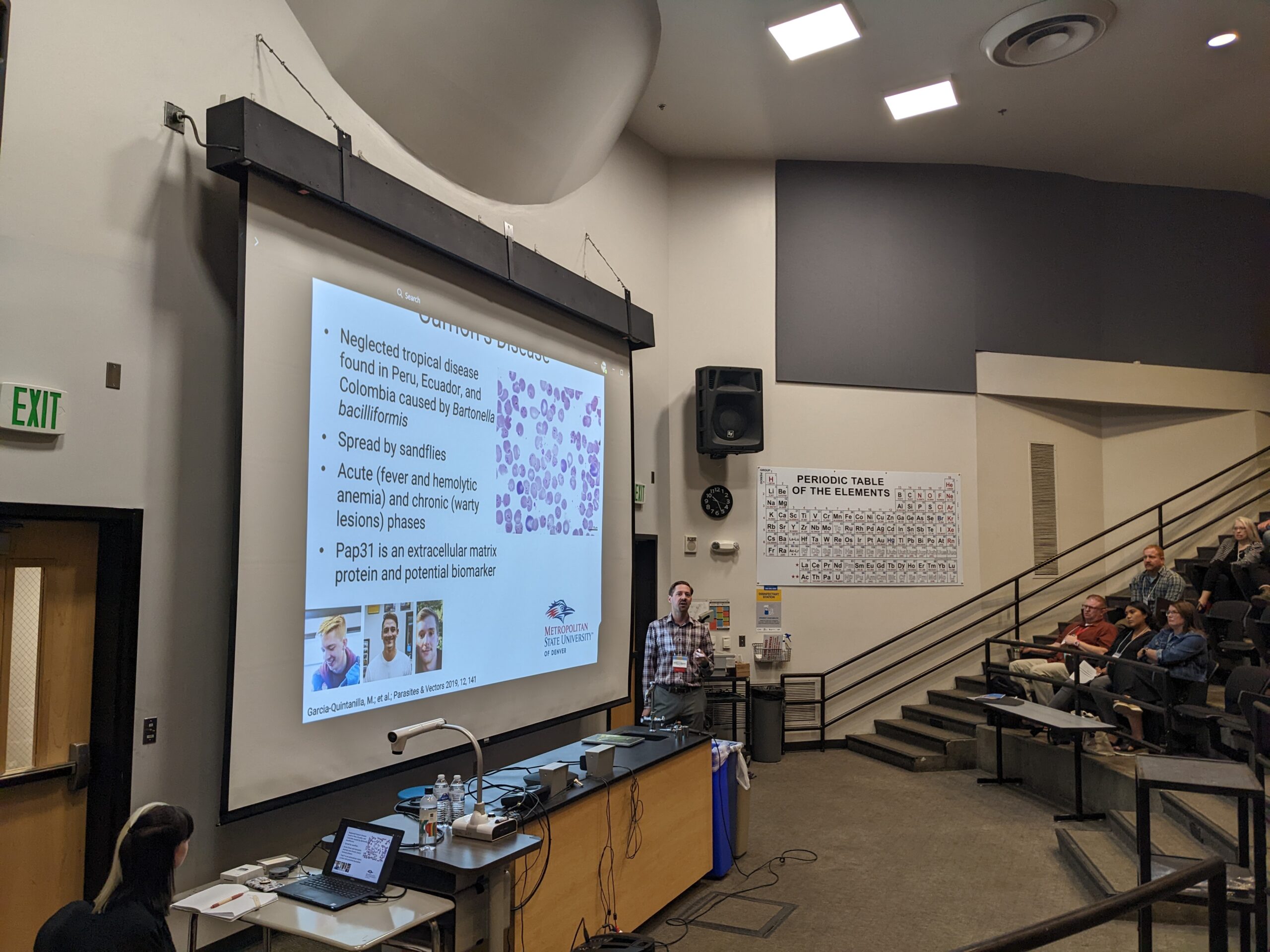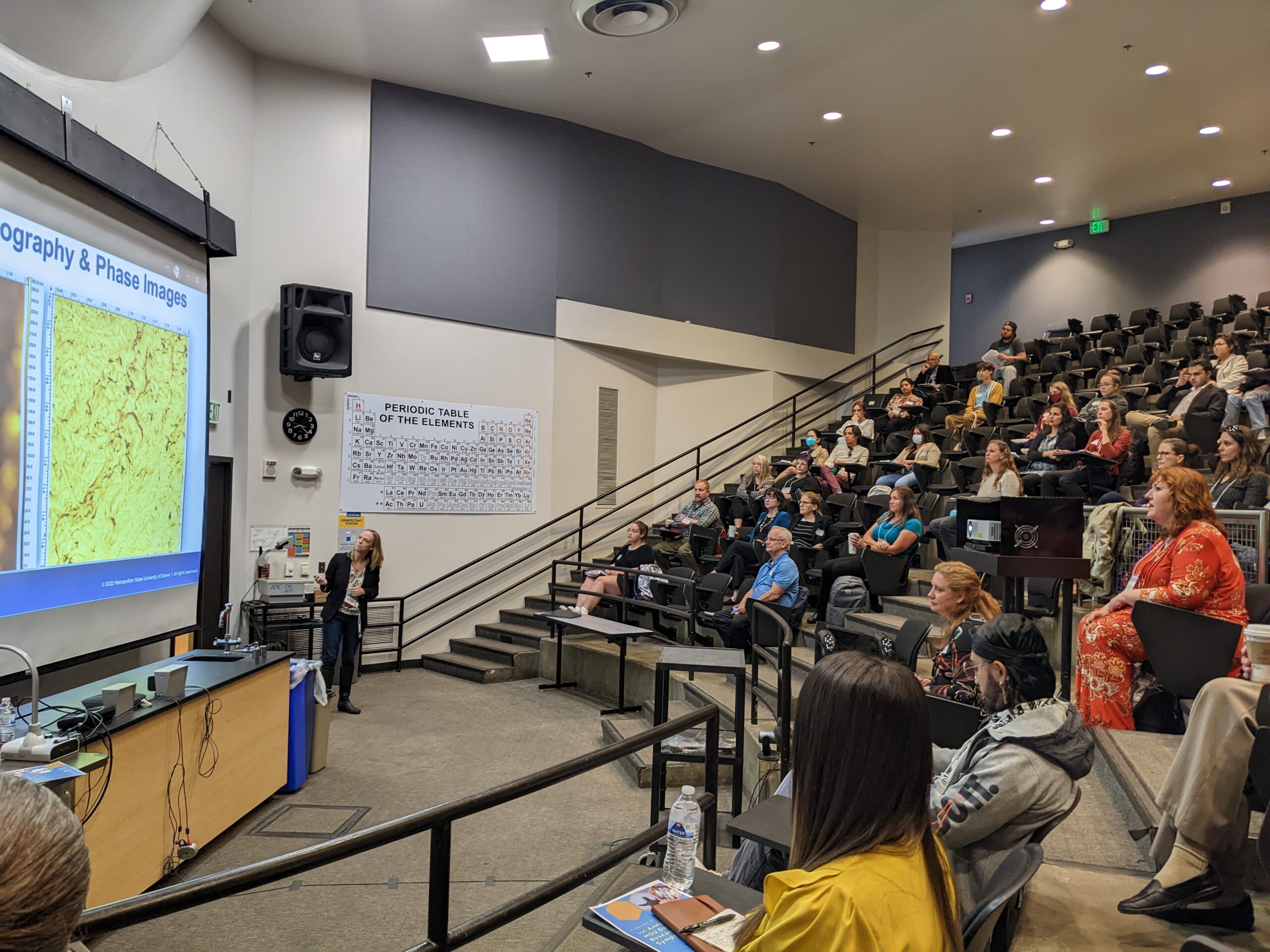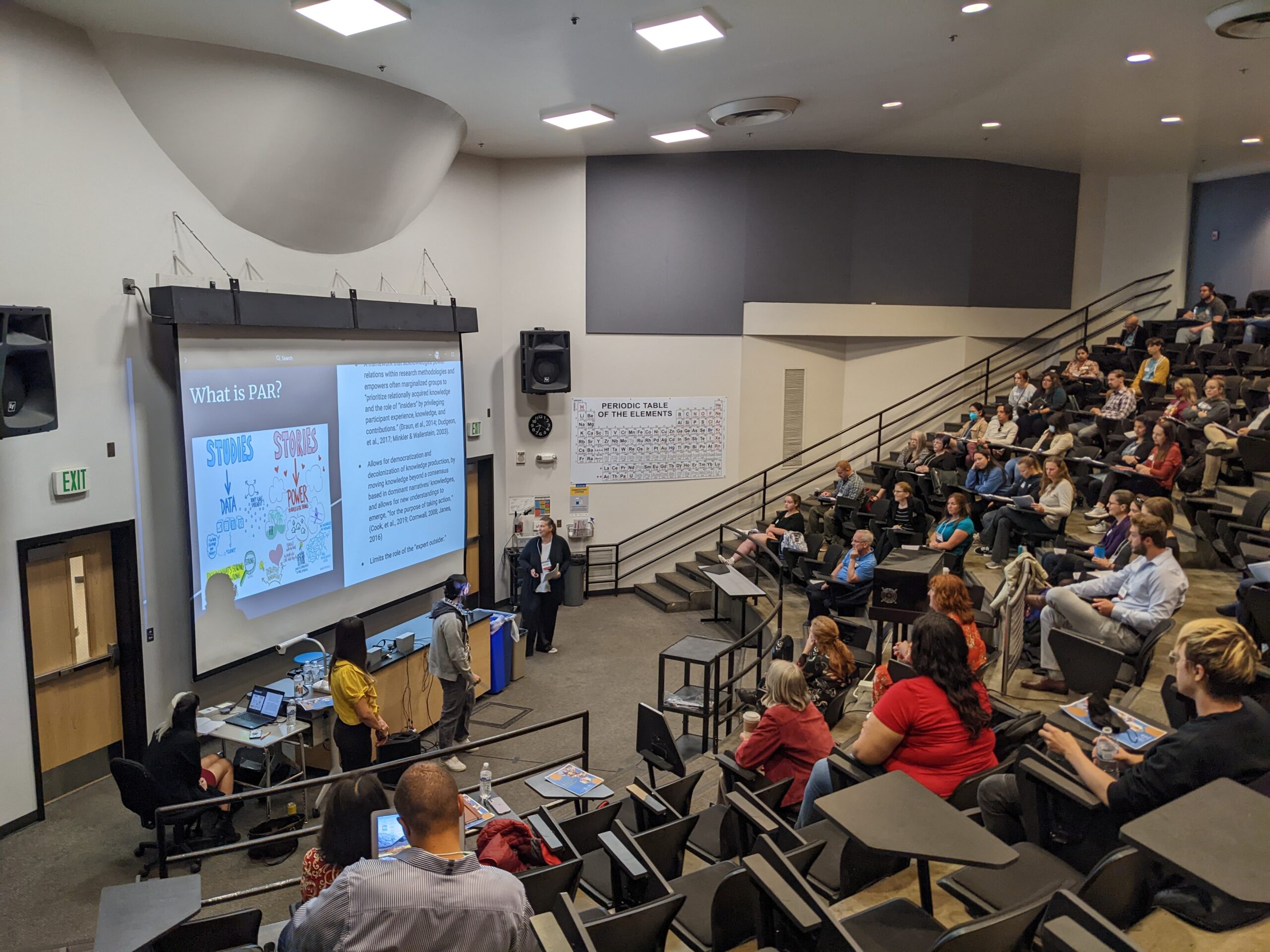
MSU Denver Research Symposium Fall 2022
MSU Denver Fall 2022 Research Symposium
October 21st, 2022
Hosted across the MSU Denver Campus.
Presentations by both faculty and students.
The Honors Program and the Undergraduate Research and Creative Scholarship Program are partnering to organize a new annual event that will connect aspiring undergraduate and graduate researchers with MSU Denver faculty researchers while showcasing the breadth and depth of research activities happening on our campus. This year, 23 faculty and 8 students from across the disciplines will present their research projects in a series of brief, 7-minute talks at the Symposium.
Itinerary:
Session I: 9:00-10:15
(Presentations by 8 faculty, 2 students)
Science Building, Room 1067
Session II: 10:30-11:45
(Presentations by 7 faculty, 3 students)
Science Building, Room 1067
Networking Lunch: 12:00-1:30
(free for registered participants)
St. Cajetan’s
Session III: 1:45 -3:00
(Presentations by 8 faculty, 1 student)
Science Building, Room 1067
Faculty Happy Hour: 3:30-5:30
Springhill Suites, Reception Hall, 2nd floor
See the full schedule of presenters below, listed in order of appearance. Click on the + sign to read a short description of each speaker’s presentation.
*Denotes a student presenter
Presenter Schedule & Descriptions
Session I: 9:00-10:15 (Presentations by 8 faculty, 2 student)
Philosophy, History
The Jewish and Christian Bibles have been interpreted to value certain lives more than others. From its composition, texts like Deuteronomy and Joshua made a distinction between insider and outsiders, proclaiming those on the outside were necessarily disposable. The Christian Bible, from its beginnings too, demarcated those whose lives were of less value, for example, ending its discourse by killing all those who opposed Christianity in the Apocalypse of John. The term “necropolitics” comes from the work of African philosopher, Achille Mbembe, who utilized this term to discuss ‘who may live and who must die’ in modern political orders. Mbembe’s work demonstrates how ideology impacts the parameters of life for the undervalued, turning them into the living-dead. I will consider how, in modernity, monarchs, sectarians, nation-states, and political parties have marshaled biblical texts to adjudicate deaths of various kinds for certain peoples.
Physics
In the search for feasible and economical strategies for increasing usage of renewable energy sources, thermoelectric energy conversion is a promising approach for reducing energy consumption and reusing waste heat generated in industries such as manufacturing. Over 60% of the energy consumed in the US is lost as waste heat that is not recycled for use again. Thermoelectric (TE) materials are materials that convert heat into usable energy. Although devices made of TE materials such as Bi2Te3 are some of the most efficient in TE energy conversion, these materials can be toxic, scarce, expensive, and inflexible. Single walled carbon nanotube films, offer advantages over inorganic TE materials due to their abundance, flexibility, lower cost, and tunable thermoelectric properties. In this talk, I share results from an ongoing collaboration with the National Renewable Energy Laboratory focused on characterizing these carbon nanotube films and future steps toward integrating these materials in TE devices.
Criminal Justice & Criminology
How do relatively stable societies unravel into violence? As it turns out, it happens in much the same way that people become dangerous violent criminals—just on a larger scale—and the process follows very specific patterns. This project explains the underlying theory of violentization, follows the patterns of how it is manifested at the societal level through various case studies, offers a brief glimpse of the nonlinear dynamics methods used to model the patterns of violentization at the societal level, and suggests ways of exiting the process.
Social Work & Environmental Engineering
Over the last three years, Epic Scholars has been engaging in Participatory Action Research to evaluate their programming and ensure the best services and resources for independent students on the MSU Denver campus. During this time, we have completed two University wide needs assessments, listening tours with participants in Epic Scholars, and one year of evaluation. One primary focus on this evaluation was to increase our knowledge and expertise in implementing a peer leadership model. Based on feedback from the research team and the data collected, this year we implemented a peer leader training model that we anticipate will increase the benefits of peer leadership both for students and peer leaders. We will end this presentation with two members of the PAR team sharing what being part of this team has meant for them as scholars and individuals.
English
Northern Shovelers (Spatula clypeata) overwinter in Colorado. Between November and March, these ducks have been routinely observed feeding in large groups, often exceeding several hundred individuals. This feeding behavior is observed consistently in the same water bodies throughout the winter but is not observed in other lakes that are nearby. It is unclear why these ducks choose some lakes over others. The objective of our study is to verify where shovelers frequently display this mass feeding behavior. A second objective is to identify what properties, both biotic and abiotic, promote this behavior. In the winter of 2021/2022, we evaluated approximately 20 lakes for the behavior, only two lakes consistently had over 100 shovelers mass feeding 100% of the time and this behavior was never witnessed on the other lakes. The lakes where the behavior was observed were similar in surface area and dissolved oxygen concentrations. Understanding the conditions that promote this behavior will aid in management decisions regarding protection of various water bodies.
This is the story of how the idea of looking for viral signal in wastewater spread quickly around the world, including Colorado, where recent Metro grad Tracy Fielder and I were the first to show we could detect it, in late April, 2020. This proof of principle was important in launching the current coalition (CDPHE, more than 20 wastewater utilities and CSU where samples are tested). My role was to answer practical questions about best practices for processing samples, and that is the focus of my talk.
Session II: 10:30-11:45 (Presentations by 7 faculty, 3 students)
This study highlights the first year findings of a longitudinal study that uses Trauma-Informed Practice (TIP), Reflective Consultations (RC), and TIP Online Modules (OM) with first-year teachers (NT). We explore how RC and OM support NT in lowering secondary traumatic stress (STS) and sustaining TIP knowledge compared to the delayed treatment group. This paper focuses on the quantitative results of a mixed methods study. Researchers surveyed 90 novice teachers across the U.S. in their first year of teaching using various scales. Early findings indicate that TIP RC and OM sustain or increase TIP knowledge in the intervention groups. Because of the large attrition of teachers in their initial years of teaching, identifying ways that mitigate possible sources of burnout and attrition is beneficial in building resiliency in educators by attending to STS and other TIP strategies early in their careers.
Psychology
This study examined different methods for effectively preparing female rape victims, who can be considered vulnerable witnesses, to reduce confidence-accuracy bias and increase conviction rates in female sexual assault cases. Through a semi-structured interview process interviewing advocates within the criminal justice system, who work directly with female sexual assault victims, we hoped to better grasp how the system can better facilitate this vulnerable population in trial and answer the question: How can effective witness preparation reduce confidence-accuracy bias for female rape victims in jury trials?
Wireless Emergency Alert (WEA) messages were used by U.S. officials early in the Covid-19 pandemic to try to thwart the spread of the virus by communicating health information via mobile technology. I’ll present the results of an assessment of the extent to which WEA messages were successful in slowing the spread of Covid-19. This is joint work with Hamilton Bean, Alex Koutsoukos, and Abigail Meyer, all of the University of Colorado Communications Department.
Professional educational programs can support students in understanding personal well-being by increasing student knowledge and breaking down barriers of access. Being well in a profession of well-being’s approach was to understand our relationship with stress, to consider its origins, and to acknowledge our whole selves; to support future professionals as they learn about personal and collective trauma and how engaging in practices that can heal will support their goals of individual and collective transformation. The course consciously used narratives and practice to examination a healing justice framework which thrived in a classroom community.
Finance and Economics
Participation in an honors program provides a variety of benefits and impactful learning experiences. That said, the honors experience within many Institutions of Higher Education is sometimes characterized by selectivity, elitism, and exclusivity. This presentation will address a study examining the impact of a Pre-Honors program at MSU Denver specifically aimed at expanding access to honors for students with lower-GPAs. Preliminary findings suggest that when exposed to interventions, the recruited students engage in similar registration behavior as existing honors students. The researchers hope the results of this experiment will lead to the development of strategies that may support the success of students who enter honors with a lower GPA, inform the role of peer effects in honors, and help explain how much of the positive impact that honors exists for students who do not meet traditional honors profiles.
Neglected tropical diseases predominantly infect low-income populations across the globe; due to their absence in developed countries, there are far fewer diagnostics and treatments for these diseases then are needed. To address this problem, my research focuses on the discovery and optimization of molecular diagnostic tools based on the structural and thermodynamic properties of DNA. Current projects are generating sensitive, low-cost, and field-portable tests for both Carrion’s Disease (CD) and Non-Tubercular Lung Disease (NTLD). CD is caused by infection with B. bacilliformis, and is endemic in northern Peru and South America. NTLD is common in tropical and subtropical regions ranging from Indonesia to Florida, and is caused by infection with Mycobacteria. In both cases, my lab works to create DNA aptamers, short synthetic pieces of DNA that can sensitively and specifically bind to bacterially secreted biomarkers. These aptamers are then joined to a portable electrochemical sensing platform to create powerful diagnostics that give results from a single drop of blood in under five minutes, and can be manufactured inexpensively for distribution.
I study and reflect on eco-artists, stories, poems, essays, short films and feature films, and new media with an environmental focus. I not only seek to confront our consumer habits and our disconnection on the cultures of “Buen Vivir” [Good Living], but to investigate the possible alternatives that emerge from these struggles for the defense and possession of the land. It is also about reflecting on how to unleash the imagination in the service of sustainability that does not adapt to the devastating dependence on extractivism. Through a selective analysis of the eco-critical contributions of various Latin American artists, filmmakers and writers I am inquiring not only on practical pedagogical suggestions to reduce the ecological footprint of our lifestyles, but above all to integrate these educational practices in spaces for debate and recovery of ancestral knowledge that impact and reorient environmental policies in local and bigger context.
Networking Lunch: 12:00-1:30 (free for registered participants)
Session III: 1:45 -3:00 (8 faculty, 1 student)
Frequent spikes in blood glucose (BG) after consumption of refined carbohydrates or sugar (referred to as high glycemic load [HGL] foods) increase risk of chronic disease development in healthy individuals, and increase diabetes complications risk in those with diabetes. Co-ingestion of peanut butter, a source of protein and fat, with a HGL meal or food may blunt the BG spike. Sixteen healthy subjects consumed a HGL breakfast on two separate days; 2 Tbsp peanut butter was added on one of the days. BG was measured before and 15, 30, 60, 90, and 120 min post-meal. The spike in BG was significantly lower on the added peanut butter day (P<0.01); BG was significantly lower at the 15, 30, and 60 min measurements, indicating a reduced overall glycemic response. Consuming peanut butter with a HGL food/meal appears to be an effective strategy to reduce BG spikes, which could reduce chronic disease risk.
While current research indicates that humans might form a Theory of Mind (ToM) while interacting with a social robot, existing research methods in Human-Robot Interaction often focus on the assessment of only a small number of distinct robot designs. The lack of diversity in existing robot designs also prevents meaningful analysis into ToM using Machine Learning (ML) techniques, as there is no large enough training corpus to provide reliable results. Even if this lack of data was addressed and a ML model was created, however, there is no comprehensive independent metric that could evaluate the correctness of such learned models, a key component in building trust in the ML predictions. To address these issues we developed a novel research platform implemented as a web-accessible 3D game, DU Build-A-Bot, that will allow us to gather a large number of user-provided robot design examples that are associated with a mental state. The goal is to use this data to train machine learning models that can validate and predict the Robot Theory of Mind (RToM) associated with a given design. We will then use neuroscientific measures to independently validate the data collected from the platform as well as the machine learning models. The integration of a novel robotic design platform for data collection, ML models, and neuroscience measures will allow us to gain significantly new insights into a Robot Theory of Mind.
My research examines the growth of platform capitalism by centering platform laborers in the Philippines. I focus on the work of “care coaches,” where people based in the Philippines and Mexico work round-the-clock to remotely monitor and interact with an elderly US-based clients via a computer tablet. The interactions with the client are mediated by an avatar of an animated dog or cat. Internet and communications technology (ICT) have made possible the transnational distribution of carework and intimate labor without the migration of laborers themselves. Accelerated by the COVID 19 pandemic, these shifts to ICT economies offer a unique opportunity to study social transformations generated by new assemblages of technology and labor. Using care coaches as a case study, I examine how digital carework maintain an international division of reproductive labor by engendering extraction of Southeast Asian workers’ intimate labor to sustain the lives of people in the Global North.
Chemistry and Biochemistry
Unlike most eukaryotic translation, Blackcurrant Reversion virus (BRV) lacks a 5′-m7GpppN cap (5’cap), and initiates translation using a structured RNA in its 3′ untranslated region (UTR) called a cap-independent translation enhancer (CITE). CITE binds to translation machinery and delivers that machinery to the 5′ UTR, typically via an RNA kissing-loop interaction. Our research focuses on these 3′ CITE and 5′ UTR RNA structures and their significance in facilitating translation. Using site-directed mutagenesis to generate mutants and a luciferase reporter to measure protein production, we analyzed the relationship between structure and function. We found that increased stem structure decreased translation efficiency, whereas decreased stem structure increased translation efficiency. We propose the increased structure “masked” bases and decreased structure “unmasked” bases that are involved in the end-to-end kissing-interaction and affect protein production. As a lesser-known viral CITE, this study aids further understanding of plant viral CITE structures and their translation initiation mechanism.
I have been researching for my 5th book since the summer of 2021 “On the Cusp of Chaos: 1857 Colorado.” I selected this title as it represents the relative calm in 1857 Colorado before storm of the impending Colorado Gold Rush of 1858. For the most part it was sparsely inhabited with bands of nomadic tribes of Comanche, Cheyenne and Arapahoe hunting the herds of bison of eastern present-day Colorado plains. I have been focusing my research on southeast Colorado’s Arkansas River Valley to write and present this first chapter for presentation to a history conference. Future chapters will include southwest, northwest, and northeast regions of Colorado. My research has included to travels to Washington DC’s National Archives, historic sites, museums, and historic societies. I have also worked with the History Department and the National Park Service to create internship programs for MSU Denver students.
The paper explores the connection between the philosophy of design and ancient philosophies, especially Greek, Chinese, and Japanese, by creating connections that offer a new scope to the design discourse. Philosophy can elevate the creative process to an ethical endeavor, leading society to the creation of better and more meaningful artifacts, better and more meaningful design methods, and, especially, to the creation of a more ethical society. Ancient philosophy can also help create a more sustainable society through the understanding and application of the concepts of harmony and balance as expressed in the ancient Chinese book of Tao Te Ching and create new aesthetic concepts based on the semiotics and cultural concepts of impermanence, transience, and imperfection, coherent with the needs of reducing the natural resources extracted from Earth.
The light-gray Early Jurassic Springdale Sandstone Member of the Moenave Formation at historic Silver Reef and Harrisburg, now Leeds, UT is a place of one of the most unusual precious metal deposits in the world. This presentation will familiarize the audience with our undergraduate / faculty research projects in MSU Denver Applied Geology of this unusual mineralization and our friendly research connection to the USGS (United States Geological Survey).



















